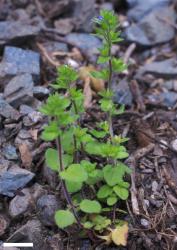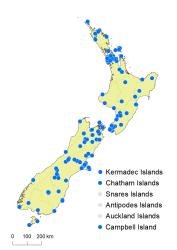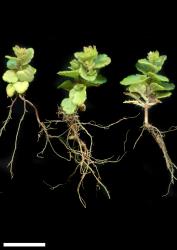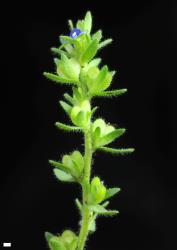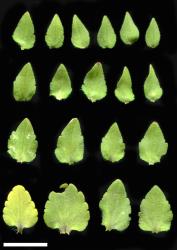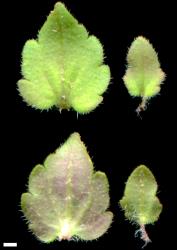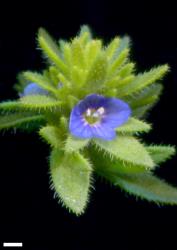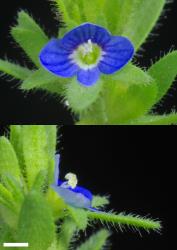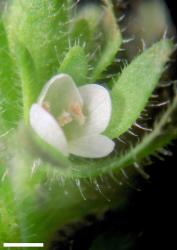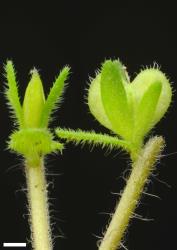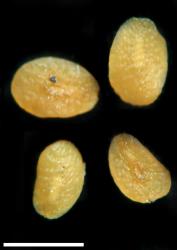- = Veronica hirsuta Colenso, Trans. & Proc. New Zealand Inst. 24: 393 (1892)
Annual herb to 0.45 m tall. Stems decumbent to erect; hairs of two types: dense, bifarious, antrorse, short, eglandular; and sparse, long, uniform, eglandular or sometimes glandular. Leaf bud indistinct; leaves separating while very small, opposite-decussate, erecto-patent to spreading; lamina thin, elliptic to ovate or sub-orbicular, becoming deltoid above, 5–20 mm long, 3–12 mm wide, dull green above, pale green to pinkish beneath; midrib and secondary veins distinct; surfaces eglandular-pubescent above and beneath, at least on veins; margin pubescent, serrate-crenate to serrate-dentate; teeth in 3–6 pairs; apex obtuse to sub-acute; base truncate to sub-cordate; petiole 0–4 mm rarely to 10 mm long. Inflorescence a terminal spike or raceme, 5–40 mm long; flowers crowded, distant at fruiting, 5–60, all bisexual; bracts alternate, lowest leaf-like, becoming lanceolate-elliptic, > pedicels; pedicels erecto-patent, 0–2 mm long, eglandular-pubescent all around. Calyx lobes 4, sub-acute to acute, unequal (the posterior ½–¾ the anterior), 1.5–3.0 mm long, elongating to 5–6 mm at fruiting, glandular- and eglandular-hairy. Corolla 2–3 mm diameter; tube white and yellow, 1 mm long, < calyx, glabrous; lobes 4, blue, rarely white or pinkish, erecto-patent, unequal, elliptic to orbicular, 1.0–1.5 mm long, rounded; nectar guides dark blue. Stamen filaments white, 0.5–1.0 mm long; anthers blue. Style glabrous, c. 0.5 mm long. Capsules angustiseptate, obcordate, glandular- or eglandular-ciliate on edges, 2.5–3.0 mm long, 3–4 mm at widest point. Seeds ellipsoid, flattened, smooth, pale brown, 1–1.2 mm long.
V. arvensis plants can be recognised by a combination of characters: short, bifarious, mixed with long, uniform stem hairs, leaves toothed but not deeply lobed, tiny bright blue (very rarely white) sessile flowers in a terminal inflorescence, small, obcordate ciliate capsules, and flattened seeds.
V. verna plants have a similar growth form, with sessile, small blue flowers and flattened seeds, but can be distinguished by having only short stem hairs (glandular above), upper leaves and lower bracts lobed to at least halfway, and pubescent faces on the capsules (glandular on capsule margins). V. triphyllos plants have rather larger blue flowers, digitately lobed leaves, densely glandular inflorescence and calyx, much longer pedicels at fruiting, larger capsules, and cup-shaped seeds.
V. arvensis plants have been misidentified as V. polita. V. polita plants have rather larger flowers with longer pedicels, and even their uppermost bracts are leaf-like. Their capsule lobes are rounded, only weakly flattened, and hairy all over. Their seeds are wrinkled and cup-shaped.
North Island: throughout.
South Island: throughout.
Kermadec Is., Chatham Is., Stewart I., Campbell I./Motu Ihupuku.
Open, modified and disturbed habitats, waste places, roadsides, arable land, short, poor, and depleted pasture, lawns, stream beds, and cliffs. Recorded elevations range from 0 to 1360 m.
Kirk, T. in Hooker (1864, p. 217). Voucher: not located.
Flowers: July–April (mostly October–January); fruits: August–June (mostly November–May).
2n = 16 in Europe (Albach et al. 2008).
Veronica arvensis is classified in V. subg. Chamaedrys (Albach et al. 2004; Albach & Meudt 2010).
In V. arvensis the transition between leaves and bracts is gradual, so that lower bracts are leaf-like and may be coarsely few-toothed.



